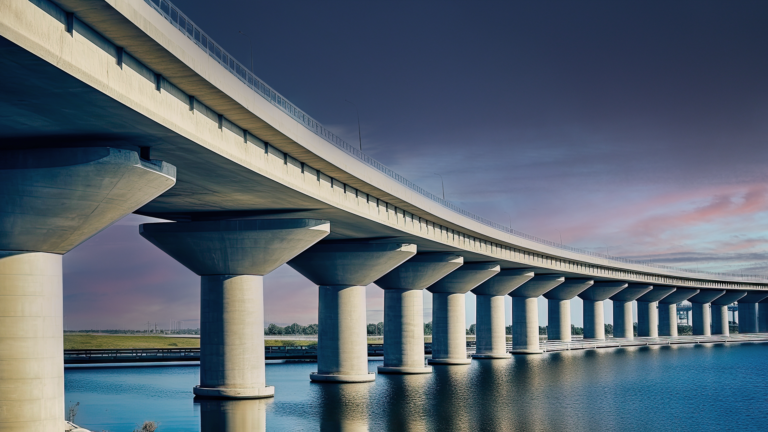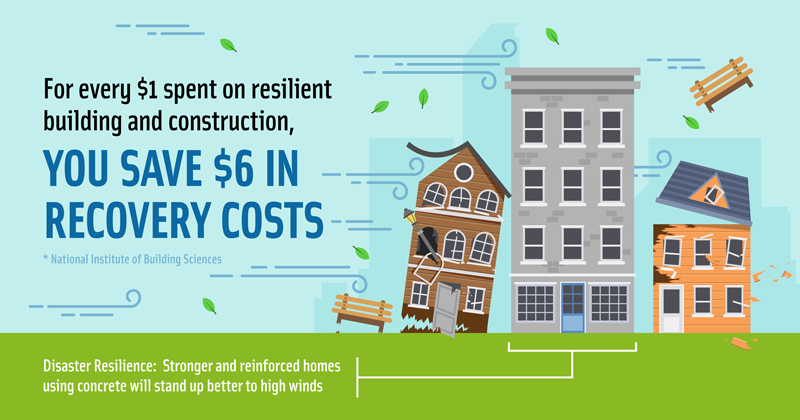
The Resilience of Concrete
Stronger and Safer
Among all construction materials, concrete stands out for its exceptional durability and its ability to withstand natural disasters. This makes concrete structures essential for creating stronger, safer communities—especially when comprehensive planning and stricter building codes are in place. Resilient structures are also the new “green” buildings. Builders, architects, and designers recognize that durable public buildings, homes, and businesses minimize environmental impact.
Disaster Resilience
In 2017, the 16 largest weather events each caused over $1 billion in damage. We can expect climate change and other factors to lead to more frequent billion-dollar disasters—unless we start building more resilient structures. U.S. taxpayers cannot afford to continue building and rebuilding the way we did in the past. Concrete construction offers long-lasting solutions to build safe, prosperous communities anywhere in the country.

-
- Reinforced concrete construction is better able to survive major storms. For example, concrete wall, floor, and roof systems provide unmatched structural strength and wind resistance. Hardened exterior finishes for walls and roofs offer superior strength and security. That means less need for repair and reconstruction.
- People living or working in reinforced concrete buildings can safely shelter in place during major storms, minimizing the need for emergency response. In fact, most safe rooms and shelters are made with concrete systems.
- Concrete is non-combustible, giving concrete buildings excellent fire ratings. This allows occupants time to escape to safety and increases the chances that the structure will survive.
-

Comparisons of Resilient Characteristics by Structural System Demonstrating Resilience
After Superstorm Sandy devastated a swath of New York City’s coastal communities, the Portland Cement Association (now the American Cement Association), the Federal Alliance for Safe Homes, Inc., and others partnered to help create a hurricane-strong home for one NYC resident—a powerful demonstration project.
Meeting or Exceeding Codes
Many people don’t know that building code compliance provides only minimum levels of safety. Code requirements for fire ratings are designed to give people enough time to escape—but not necessarily to protect the structure. Code compliance does not guarantee resilient performance. In a building that is not resilient, any disaster can result in complete structural loss, loss of material possessions, and community devastation.
Resilient construction allows occupants adequate time to escape or even to shelter in place, and may protect the structure so that it can be repaired rather than replaced.
How Concrete Can Help
-
- Concrete is noncombustible. In the event of fire, the structure does not provide fuel for the fire and may contain it.
- Concrete walls, floors, and roofs are recognized by the International Building Code as providing a good fire rating, usually a 1–2-hour rating for about 3 to 5 inches of concrete.
-
Reinforced concrete, which meets or exceeds code minimums without extra effort for design or construction, can resist destructive forces like fire, high winds, and storm surge.
Durability
Durability means two things: the ability to stand up to normal wear and tear and last a long time; and the capacity to resist extreme events like natural or man-made disasters.
Concrete can be cost-competitive, last a very long time, and cost owners much less in maintenance and repairs over the building’s lifetime. Resilient structures are good for the planet, too, because their environmental footprint can be spread over many decades.
How Concrete Can Help
-
Concrete can be used for construction in all climates. It is non-combustible, and does not rot, warp, grow mold, or sag when exposed to moisture over time.
-
There is tangible value in using durable materials for construction. Structural materials and finishes that resist deterioration minimize the costs for maintenance. Over the life of a building, the expected cost of maintenance and post-disaster repair can exceed initial building costs—making an economic case for investing up front in resilient construction.
Resilience and Carbon Footprint
All construction materials emit CO2, a greenhouse gas, during manufacture—but that’s only part of the story. Other factors help determine the carbon footprint of a building: the building’s energy usage and how long the building lasts. Long life plus good energy efficiency help minimize harmful CO2 emissions.
How Concrete Can Help
-
Concrete is a heavy material, so it takes a lot of energy to heat or cool it. That means it changes temperature slowly. This phenomenon is known as “thermal mass.” The thermal mass of concrete slows down heat transfer and translates to decreased energy needed for heating and cooling. Plus, concrete walls form a tight envelope to eliminate gaps in walls and reduce drafts and hot or cold spots.
-
Concrete systems are built to last a long time—even if they’re exposed to extreme weather events. The durability results in minimal costs for maintenance and repair. And the greater resilience of concrete buildings equals more sustainable construction. Longer use results in less emissions from the manufacturer of new materials to build a new structure.